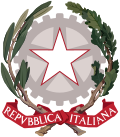Yugoslav period
In 1915, the Kingdom of Italy signed the secret Treaty of London with members of the Triple Entente. According to the pact, Italy was to declare war against the Triple Alliance; in exchange, she was to receive the Julian March, northern Dalmatia and the protectorate over Albania.
In 1918, Ante Trumbić, of the Yugoslav Committee and the Italian representative, Andrea Torre, signed an agreement which clearly stated that the future border between the Kingdom of Yugoslavia (the union of the Kingdom of Serbia and the State of Slovenes, Croats and Serbs) would be decided in a democratic way.
In 1918, after the surrender of Austria-Hungary following the Armistice of Villa Giusti, Italy occupied militarily the Julian March, Istria, the Kvarner Gulf and Dalmatia, all Austro-Hungarian territories. On the Dalmatian coast, Italy established the Governorate of Dalmatia, which had the provisional aim of ferrying the territory towards full integration into the Kingdom of Italy, progressively importing national legislation in place of the previous one.
However, the Treaty of London was nullified in the Treaty of Versailles due to the objections of American president Woodrow Wilson. Italy received only the Julian March, the Dalmatian city of Zara (Zadar), as well as the islands of Cherso (Cres), Lussino (Lošinj) and Lagosta (Lastovo). A large number of Dalmatian Italians, (allegedly nearly 20,000), moved from the areas of Dalmatia assigned to Yugoslavia and resettled in Italy (mainly in Zara). Following the conclusion of World War I and the disintegration of Austria-Hungary, Dalmatia became part of the newly formed Kingdom of Serbs, Croats and Slovenes (later renamed the Kingdom of Yugoslavia).
After the failure of a border agreement at the Paris Peace Conference, discussions continued between the Kingdom of Italy and the Kingdom of Yugoslavia. During 1920 the Italian government was under internal pressure to expand her borders as fair compensation for war victims and war debt. An example of this pressure was the publication of a forged letter purporting to be from Abraham Lincoln to Macedonio Melloni, in which Lincoln had apparently acknowledged all the coast between Venice and Cattaro as Italian national territory. [5] Relations seemed to settle with the signing of the Treaty of Rapallo, the annexation by Italy of the Free State of Fiume and the evacuation of the Governorate of Dalmatia.
Relations with the Kingdom of Yugoslavia were severely affected and constantly remained tense, because of the dispute over Dalmatia and over the city-port of Fiume (Rijeka). It had become a free state according to the League of Nations, but was occupied by some Italian rebels led by the writer Gabriele d'Annunzio. In 1924 the city was divided between Italy and Yugoslavia (the Treaty of Rapallo). Fascism came to Italy in 1922. Their policies included nationalistic Italianization courses of action, under which minority rights were severely reduced.
The Invasion of Yugoslavia in World War II was the Axis powers' attack on the Kingdom of Yugoslavia which began on 6 April 1941. The invasion ended with the unconditional surrender of the Royal Yugoslav Army on 17 April 1941, the annexation and occupation of the region by the Axis powers and the creation of the Independent State of Croatia (Nezavisna Država Hrvatska, or NDH). Italy annexed the area constituting the province of Ljubljana, the area merged with the province of Fiume and the areas making up the second Governorate of Dalmatia.
The end of the war on the Italian-Yugoslav border, after the Italian capitulation on 8 September 1943, was marked by the foibe massacres (perpetrated by Yugoslav partisans) that took place mainly in Istria from 1946 to 1949, the Istrian–Dalmatian exodus, which involved the emigration of around 350,000 Istrian Italians and Dalmatian Italians, [6] and the issue of Trieste. [7]
The Socialist Federal Republic of Yugoslavia was one of only two European countries that were liberated by its own forces during World War II, with limited assistance and participation by the Allies. It received support from the Western democracies and the Soviet Union, and at the end of the war no foreign troops were stationed on its soil. Partly as a result, the country found itself halfway between the two camps at the onset of the Cold War.
In 1947–1948, the Soviet Union attempted to command obedience from Yugoslavia, primarily on issues of foreign policy, which resulted in the Tito–Stalin split and almost ignited an armed conflict. A period of very cool relations with the Soviet Union followed, during which the US and the UK considered persuading Yugoslavia into the newly formed NATO. This changed in 1953 with the Trieste crisis, a tense dispute between Yugoslavia and the Western Allies over the eventual Yugoslav-Italian border (see Free Territory of Trieste), and with Yugoslav-Soviet reconciliation in 1956. This ambivalent position at the start of the Cold War matured into the non-aligned foreign policy which Yugoslavia actively espoused until its dissolution.
The issue of the status of Trieste was finally settled with the 1975 Treaty of Osimo, signed by the two countries in Osimo, Italy, to definitely divide the Free Territory of Trieste between the two states. The treaty was based on the memorandum of understanding signed in London in 1954, which had handed over the civil administration of Zone A to Italy and Zone B to Yugoslavia. Zone A, including the city of Trieste, became the Italian Province of Trieste, but Yugoslavia was granted free access to its port.





